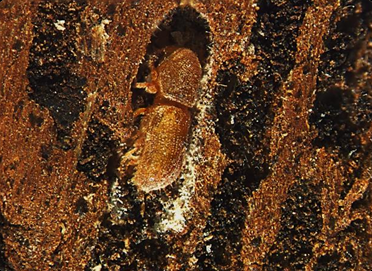2018 SRE Project
Ecological Niche Modeling and Risk Assessment of Thousand Cankers Disease
Participants:
Benjamin Schenck, College of William and Mary
Brianna Alred, Univ. of Tennessee
Ben Reber, Houghton College
Mentors:
Mona Papeş, Ecology & Evolutionary Biology; Director, Spatial Analysis Lab at NIMBioS, Univ. of Tennessee
Greg Wiggins, NIMBioS Education & Outreach Coordinator
 Project Description.
Widespread mortality of black walnut, Juglans nigra, in the western U.S. has been attributed to an insect-mediated disease known as thousand cankers disease (TCD). This disease manifests when the vector, Pityophthorus juglandis (walnut twig beetle), inoculates trees with a fungus, Geosmithia morbida. TCD was documented from black walnut in its native range in the eastern U.S. in 2010. However, the symptomology of the disease has not been as acute as in the western U.S. Greater environmental stress in the western U.S. may account for greater disease severity. Thus, under what scenarios would symptomology be more acute and mortality more widespread in the eastern U.S.? Ecological niche modeling will be combined with climate change models to characterize conditions that may contribute to greater infection and mortality in the eastern U.S. The resulting models will allow scientists and resource managers to consider management strategies for future forests.
Project Description.
Widespread mortality of black walnut, Juglans nigra, in the western U.S. has been attributed to an insect-mediated disease known as thousand cankers disease (TCD). This disease manifests when the vector, Pityophthorus juglandis (walnut twig beetle), inoculates trees with a fungus, Geosmithia morbida. TCD was documented from black walnut in its native range in the eastern U.S. in 2010. However, the symptomology of the disease has not been as acute as in the western U.S. Greater environmental stress in the western U.S. may account for greater disease severity. Thus, under what scenarios would symptomology be more acute and mortality more widespread in the eastern U.S.? Ecological niche modeling will be combined with climate change models to characterize conditions that may contribute to greater infection and mortality in the eastern U.S. The resulting models will allow scientists and resource managers to consider management strategies for future forests.
NIMBioS
1122 Volunteer Blvd., Suite 106
University of Tennessee
Knoxville,
TN 37996-3410
PH: (865) 974-9334
FAX: (865) 974-9461
Contact NIMBioS


